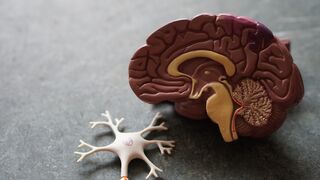Psychosis
How Researchers Study Schizophrenia
The frameworks for studying psychosis have been updated.
Posted August 22, 2022 Reviewed by Davia Sills
Key points
- Schizophrenia remains a mystery to the general public, but researchers have new strategies for studying it.
- Schizophrenia is presently referred to as a spectrum disorder in research.
- Spectrum disorders are better understood through the Research Domain Criteria (RDoC) model of research proposed by the NIMH in 2014.
- Through the combined efforts of spectrum, dimension, and RDoC frameworks, we can develop more precise ways to study psychosis.

Despite the public having a primitive perspective on schizophrenia, the research industry is making huge gains in redefining what it means to have the disorder.
More and more, it seems that psychosis can appear in gradients across, between, and within individuals.
Someone can have brief psychosis, which may only last a few months (called transient psychosis), with the symptoms never returning. Some people can develop psychosis only during the middle of a manic or depressive episode (associated with bipolar disorder with psychotic symptoms), or some may develop psychosis that is ongoing (associated with schizophrenia). All of those are branches of the same psychosis tree, despite the severe stigma attached to the term “schizophrenia.”
The renaming and redefining of the term haven’t changed much in the last century, but efforts from renaming the disorder to calling for a more precise approach to diagnosing patients are underway.
A new way of looking at schizophrenia
Many physicians and researchers now believe schizophrenia actually occurs on a psychosis “spectrum,” and in recent research, there is more of a push for researchers to refer to the illnesses related to psychosis as Schizophrenia Spectrum Disorder (SSD).
That spectrum includes an affective (mood) component and a disorganized thinking component, where bipolar disorder and schizophrenia may exist on opposite ends of the same continuum, with schizoaffective disorder existing in the middle. Five symptom dimensions describe this continuum: positive and negative symptoms, depression, mania, and disorganization.
The categorization comes as a medical necessity to determine which types of treatment are beneficial to which patient. If a person is far on the schizophrenia end, that person may require more serious implementations for care and treatment and see a reduced positive outcome.
Drugs may affect people on the continuum differently as well, and the desire to put the disorders on the same continuum comes from clinical outcomes, as seen in patients treated with lithium, for example. It doesn’t work on people with schizophrenia, but it does for people with schizoaffective disorder and bipolar disorder, so researchers believe the two are related.
There is a push to make the study and conversation of psychosis more accurate. Research focusing on psychosis is so sparse that schizophrenia is researched at least 10 times more than most of the other conditions on the psychotic disorder spectrum.
Only 30 percent of psychosis cases actually fall under the condition of “schizophrenia,” which is a unique and distinct disorder separate from its sister counterparts, like schizoaffective disorder, schizophreniform disorder, brief psychotic disorder, and depression or bipolar with psychotic symptoms.
But there is good news: the scientific psychiatry community is working to advance our understanding of psychiatric disorders in a way that honors the behavioral and biological spectrum of symptoms.
The National Institute of Mental Health, led by Dr. Thomas Insel, proposed the Research Domain Criteria (commonly referred to as RDoC) in 2014. It leads with the goal to move towards a model of precision medicine commonly used in the medical community but with the understanding that psychiatry is not yet at a place where such precision strategies can be used effectively. Precision medicine includes using biomarkers for determining if a patient is at risk for a disease, targeted treatments for specific symptoms of a given disorder, and better diagnostics.
The Bipolar-Schizophrenia Network on Intermediate Phenotypes (B-SNIP), for example, studies symptoms across the psychosis spectrum to understand the select symptoms seen across all the disorders instead of focusing on just one disorder. Each cognitive abnormality is not seen to predict symptoms (or a diagnostic label) but rather the severity or prognosis of a patient's condition.
The move towards symptom dimensionality is being developed for other disorders, too. Anxiety disorders may be the result of a single continuum of startle reactivity, with post-traumatic stress disorder existing on one end and general anxiety existing on the other.
These efforts to reorganize the way we think about research are important for developing accurate treatments that addresses the true issue at hand. The DSM-5 was developed in a way that clumped symptoms that appeared to exist in clusters, which is why we have separate disorders, such as schizophrenia and bipolar. With the movement for spectrum, dimensional, and RDoC frameworks, we can begin to thread each disorder together and produce better treatments and accurate diagnoses.
References
Guloksuz, S., & van Os, J. (2018). The slow death of the concept of schizophrenia and the painful birth of the psychosis spectrum. Psychological medicine, 48(2), 229-244.
Insel, T. R. (2014). The NIMH research domain criteria (RDoC) project: precision medicine for psychiatry. American Journal of Psychiatry, 171(4), 395-397.
Raquelle I. Mesholam-Gately, Nicole Varca, Courtney Spitzer, Emma M. Parrish, Victoria Hogan, Stephen H. Behnke, Linda Larson, Christian Rosa-Baez, Nate Schwirian, Charles Stromeyer, Michael J. Williams, Elyn R. Saks, Matcheri S. Keshavan, 2021.
Are we ready for a name change for schizophrenia? A survey of multiple stakeholders, Schizophrenia Research, 238, Pages 152-160,


